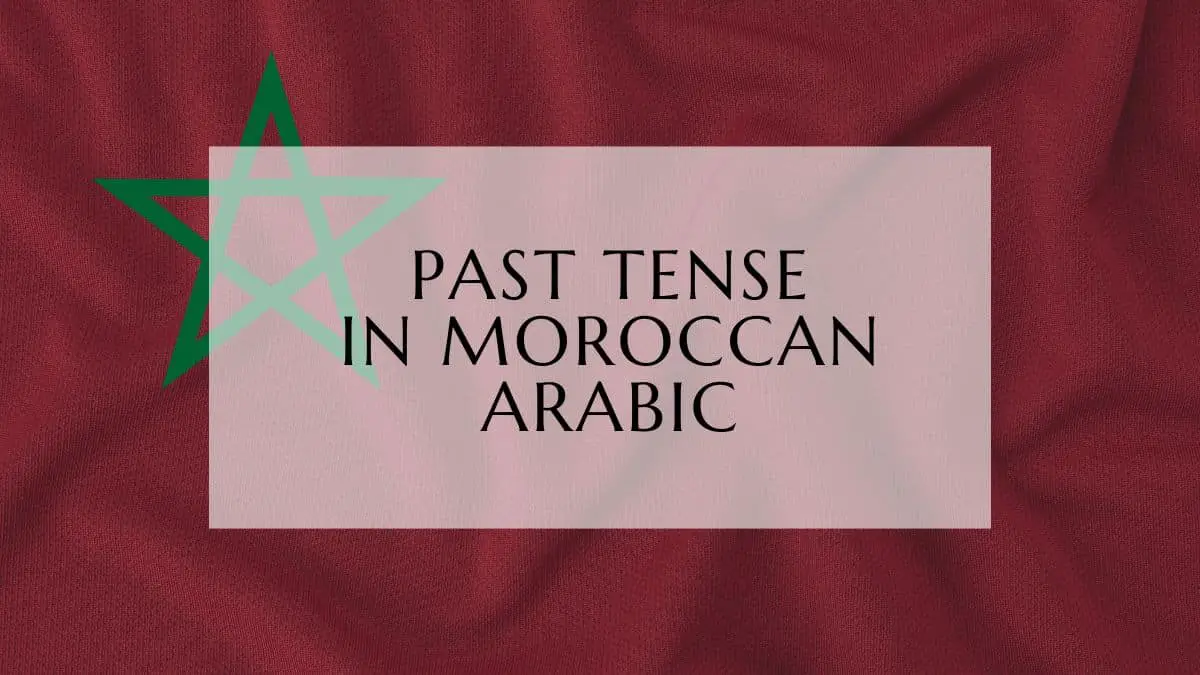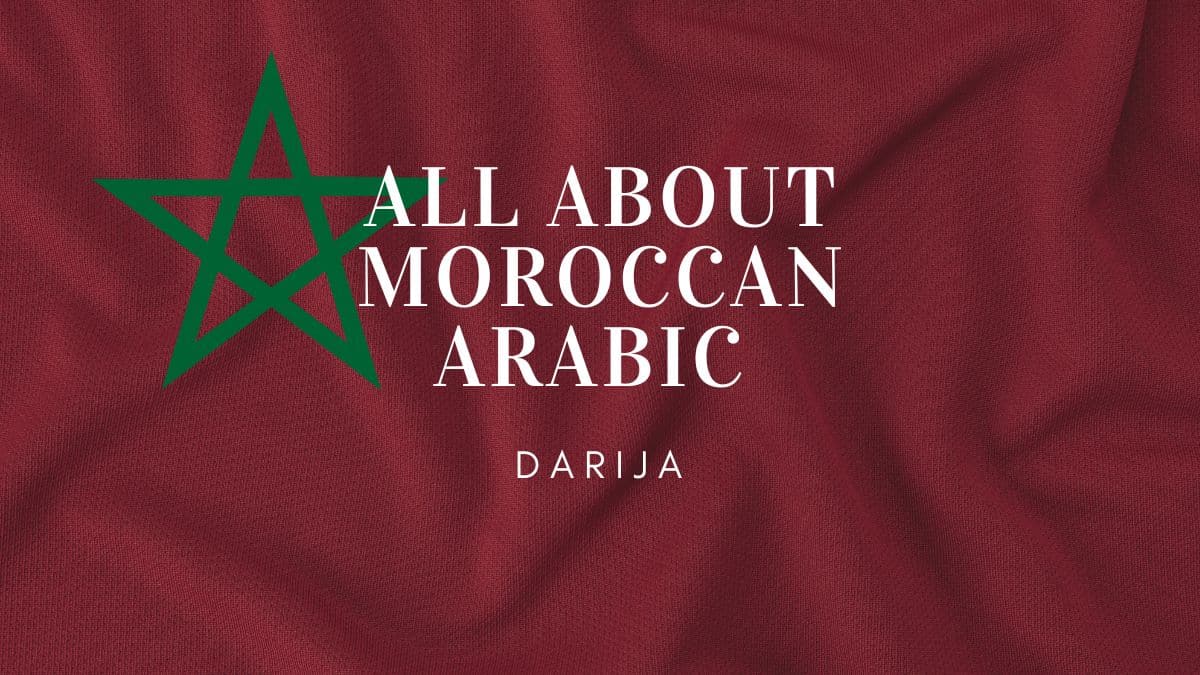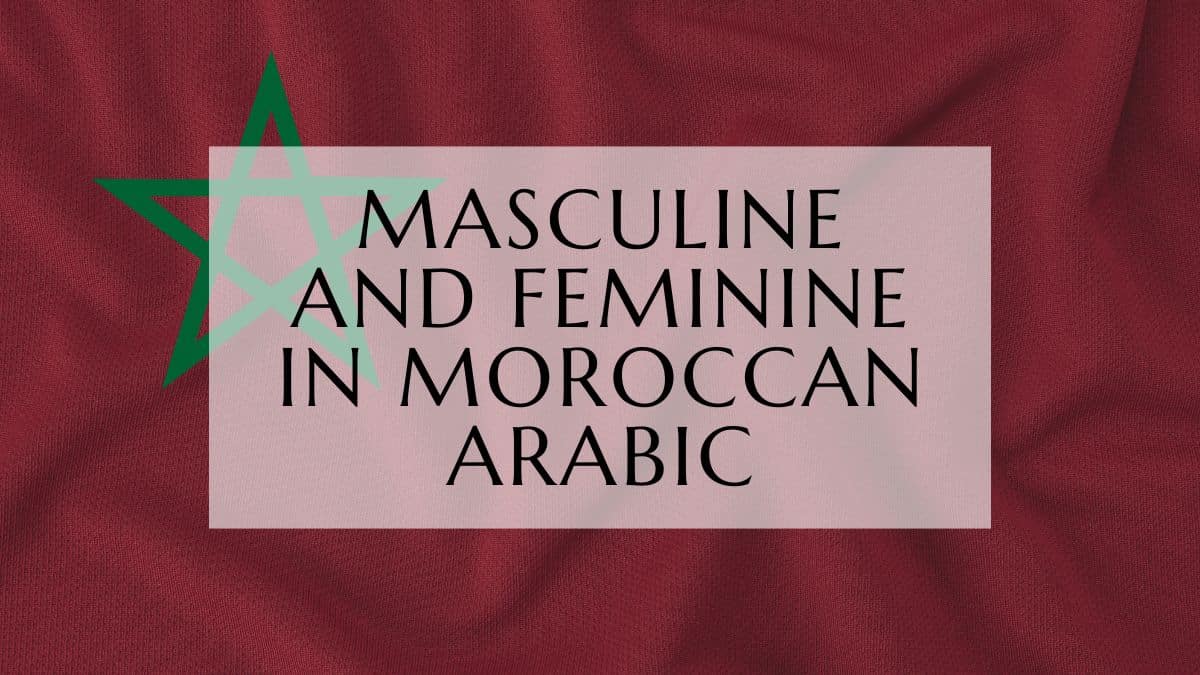In this lesson, we will discuss the past tense in Moroccan Arabic, the suffixes added to every type of the 4 Darija verb types, followed by examples. (We talked about the 4 types in this post here. Let’s get started!

Past Tense In Moroccan Arabic
The Past Tense Form In Moroccan Arabic
We will use the form below for every verb type with a few tweaks:
| English | Transcribed Moroccan Arabic | Using Arabic Alphabet |
| I (masculine) | Ana …t | أنا …ت |
| You (feminine, singular) | Nti / Ntiya …ti | نتي / نتيا …تي |
| You (masculine, singular) | Nta / Ntaya …ti | نتا / نتايا …تي |
| He | Howa …- | هو …- |
| She | Hia …at | هي …ات |
| We | 7na …na | حنا …نا |
| You (plural) | Ntuma …tu | نتوما …تو |
| They | Huma …o | هوما …و |
Note: you can practice what you’ve learned here, and learn how to pronounce each of the words in our Memrise course here, don’t know how to use the platform or sign up? we’ve got you covered in this easy-to-follow tutorial here.
Past Tense Form For CCC
To conjugate CCC verbs like ktb, lbs, gls, we just add the prefix:
Conjugation of ktb (to write) in the past:
| English | Transcribed Moroccan Arabic | Using Arabic Alphabet |
| I (masculine) | Ana ktbt | أنا كتبت |
| You (feminine, singular) | Nti / Ntiya ktbti | نتي / نتيا كتبتي |
| You (masculine, singular) | Nta / Ntaya ktbti | نتا / نتايا كتبتي |
| He | Howa ktb | هو كتب |
| She | Hia ktbat | هي كتبات |
| We | 7na ktbna | حنا كتبنا |
| You (plural) | Ntuma ktbtu | نتوما كتبتو |
| They | Huma ktbo | هوما كتبو |
Past Tense Form For CC Verbs
To conjugate CC verbs like sed, keb we add an “i” before the past tense suffix in the first and second pronouns (both singular and plural) :
Conjugation of keb (to pour) in the past:
| English | Transcribed Moroccan Arabic | Using Arabic Alphabet |
| I (masculine) | Ana kebit | أنا كبيت |
| You (feminine, singular) | Nti / Ntiya kebiti | نتي / نتيا كبيتي |
| You (masculine, singular) | Nta / Ntaya kebiti | نتا / نتايا كبيتي |
| He | Howa keb | هو كب |
| She | Hia kebat | هي كبات |
| We | 7na kebina | حنا كبينا |
| You (plural) | Ntuma kebitu | نتوما كبيتو |
| They | Huma kebo | هوما كبو |

Past Tense Form For CCV Verbs
To conjugate CCV verbs like shra, kla we replace “a” with “i” before the past tense suffix in the first and second pronouns (both singular and plural) :
Conjugation of shra (to buy) in the past:
| English | Transcribed Moroccan Arabic | Using Arabic Alphabet |
| I (masculine) | Ana shrit | أنا شريت |
| You (feminine, singular) | Nti / Ntiya shriti | نتي / نتيا شريتي |
| You (masculine, singular) | Nta / Ntaya shriti | نتا / نتايا شريتي |
| He | Howa shra | هو شرا |
| She | Hia shrat | هي شرات |
| We | 7na shrina | حنا شرينا |
| You (plural) | Ntuma shritu | نتوما شريتو |
| They | Huma shraw (o becomes w after a) | هوما شرو |
Conjugation of ja (to come) in the past:
| English | Transcribed Moroccan Arabic | Using Arabic Alphabet |
| I (masculine) | Ana jit | أنا جيت |
| You (feminine, singular) | Nti / Ntiya jiti | نتي / نتيا جيتي |
| You (masculine, singular) | Nta / Ntaya jiti | نتا / نتايا جيتي |
| He | Howa ja | هو جا |
| She | Hia jat | هي جات |
| We | 7na jina | حنا جينا |
| You (plural) | Ntuma jitu | نتوما جيتو |
| They | Huma jaw | هوما جو |
Past Tense Form For CVC Verbs
To conjugate CVC verbs like ban, tar, gal we remove “a” with (except for hiya, howa and huma) and then add the past tense suffix:
Conjugation of tar (to fly) in the past:
| English | Transcribed Moroccan Arabic | Using Arabic Alphabet |
| I (masculine) | Ana trt | أنا طرت |
| You (feminine, singular) | Nti / Ntiya trti | نتي / نتيا طرتي |
| You (masculine, singular) | Nta / Ntaya trti | نتا / نتايا طرتي |
| He | Howa tar | هو طار |
| She | Hia tarat | هي طارت |
| We | 7na trna | حنا طرنا |
| You (plural) | Ntuma trtu | نتوما طرتو |
| They | Huma taro | هوما طارو |
Conjugation of gal (to say) in the past:
| English | Transcribed Moroccan Arabic | Using Arabic Alphabet |
| I (masculine) | Ana glt | أنا قلت |
| You (feminine, singular) | Nti / Ntiya glti | نتي / نتيا قلتي |
| You (masculine, singular) | Nta / Ntaya glti | نتا / نتايا قلتي |
| He | Howa gal | هو قال |
| She | Hia galat | هي قالت |
| We | 7na glna | حنا قلنا |
| You (plural) | Ntuma gltu | نتوما قلتو |
| They | Huma galo | هوما قالو |
Moroccan Arabic Past Tense Review
Glossary of Key Terms
- CCC: Consonant-Consonant-Consonant verb root (e.g., ktb – to write)
- CC: Consonant-Consonant verb root (e.g., sed – to close, keb – to pour)
- CCV: Consonant-Consonant-Vowel verb root (e.g., shra – to buy, kla – to eat)
- CVC: Consonant-Vowel-Consonant verb root (e.g., ban – to appear/seem, tar – to fly, gal – to say)
- Darija: Colloquial Moroccan Arabic
Short Answer Quiz
Instructions: Answer the following questions in 2-3 sentences each.
- What are the four main verb types in Moroccan Arabic based on their root structure?
- What is the general rule for conjugating CCC verbs in the past tense?
- What is the specific rule for conjugating CC verbs in the past tense for the first and second person pronouns?
- How do you conjugate the CCV verb “shra” (to buy) in the past tense for “I (masculine)”?
- How does the conjugation of the CCV verb “ja” (to come) differ from other CCV verbs in the past tense?
- What is the general rule for conjugating CVC verbs in the past tense?
- Which pronouns are exceptions to the general rule for conjugating CVC verbs in the past tense?
- Conjugate the CVC verb “gal” (to say) in the past tense for “You (feminine, singular)”.
- What is the difference in pronunciation between the past tense endings for “He” and “They” in Moroccan Arabic?
- Besides the verb conjugation, what other grammatical elements are consistent across all past tense conjugations?
Short Answer Quiz Answer Key
- The four main verb types are CCC, CC, CCV, and CVC, categorized by the consonants (C) and vowels (V) in their root form.
- To conjugate CCC verbs in the past tense, simply add the appropriate past tense suffix to the root verb.
- For CC verbs in the past tense, an “i” is inserted before the past tense suffix for the first and second person pronouns (both singular and plural).
- “Shra” (to buy) conjugated for “I (masculine)” in the past tense is “Ana shrit”.
- “Ja” (to come) changes the “a” to an “i” before the past tense suffix for all pronouns, unlike other CCV verbs which only do this for the first and second person.
- For most CVC verbs in the past tense, you remove the “a” from the root verb and then add the appropriate past tense suffix.
- The pronouns “Howa” (He), “Hia” (She), and “Huma” (They) do not follow the general CVC conjugation rule and retain the “a” from the root verb.
- The CVC verb “gal” (to say) conjugated for “You (feminine, singular)” in the past tense is “Nti / Ntiya glti”.
- The past tense ending for “He” is typically “-a” while the ending for “They” is typically “-o” (or “-w” after an “a”).
- The pronouns used for each subject remain consistent across all past tense conjugations in Moroccan Arabic.
Happy learning!
Oualid Cheddadi is the founder of Lingualid, a platform that inspires independent language learners worldwide, regardless of the language they are learning. The name “Lingualid” is derived from the Portuguese word for “language,” “língua,” and the last three letters of Oualid’s name, “Lid.”



